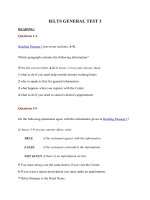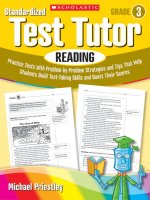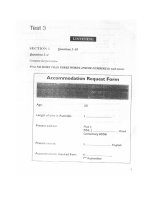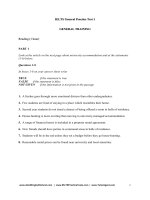ielts test 3 reading 3
Bạn đang xem bản rút gọn của tài liệu. Xem và tải ngay bản đầy đủ của tài liệu tại đây (2.85 MB, 4 trang )
Test 3
READING PASSAGE 3
Y o u s h o u ld s p e n d a b o u t 2 0 m in u te s o n
Questions 27-40,
w h ic h a re b a s e d o n R e a d in g
P a s s a g e 3 o n th e fo llo w in g p a g e s .
Questions 27-32
Reading Passage 3 has seven paragraphs, A-G.
C h o o s e th e c o rre c t h e a d in g fo r p a ra g ra p h s
B-G
fro m th e lis t o f h e a d in g s b e lo w .
W rite th e c o rre c t n u m b e r, i - x , in b o x e s 2 7 - 3 2 o n y o u r a n s w e r sh e e t.
List of Headings
i
The biological clock
ii
Why dying is beneficial
iii
The ageing process of men and women
iv
Prolonging your life
v
Limitations of life span
vi
Modes of development of different species
vii A stable life span despite improvements
viii Energy consumption
Fundamental differences in ageing of objects
and organisms
x
Repair of genetic material
E x a m p le
A nsw er
Paragraph A
V
27
Paragraph B
28
Paragraph C
29
Paragraph D
30
Paragraph E
31
Paragraph F
32
Paragraph G
74
ix
www.tailieutienganh.net - Your best IELTS material
Reading
A
Our life span is restricted. Everyone accepts this as ‘biologically’ obvious.
‘Nothing lives for ever!’ However, in this statement we think of artificially
produced, technical objects, products which are subjected to natural wear and
tear during use. This leads to the result that at some time or other the object
stops working and is unusable (‘death’ in the biological sense). But are the
wear and tear and loss of function of technical objects and the death of living
organisms really similar or comparable?
B Our ‘dead’ products are ‘static’, closed systems. It is always the basic material
which constitutes the object and which, in the natural course of things, is worn
down and becomes ‘older’. Ageing in this case must occur according to the laws
of physical chemistry and of thermodynamics. Although the same law holds
for a living organism, the result of this law is not inexorable in the same way.
At least as long as a biological system has the ability to renew itself it could
actually become older without ageing; an organism is an open, dynamic system
through which new material continuously flows. Destruction of old material
and formation of new material are thus in permanent dynamic equilibrium.
The material of which the organism is formed changes continuously. Thus
our bodies continuously exchange old substance for new, just like a spring
which more or less maintains its form and movement, but in which the water
molecules are always different.
C
Thus ageing and death should not be seen as inevitable, particularly as
the organism possesses many mechanisms for repair. It is not, in principle,
necessary for a biological system to age and die. Nevertheless, a restricted life
span, ageing, and then death are basic characteristics of life. The reason for
this is easy to recognise: in nature, the existent organisms either adapt or are
regularly replaced by new types. Because of changes in the genetic material
(mutations) these have new characteristics and in the course of their individual
lives they are tested for optimal or better adaptation to the environmental
conditions. Immortality would disturb this system - it needs room for new and
better life. This is the basic problem of evolution.
D
Every organism has a life span which is highly characteristic. There are striking
differences in life span between different species, but within one species the
parameter is relatively constant. For example, the average duration of human
life has hardly changed in thousands of years. Although more and more people
attain an advanced age as a result of developments in medical care and better
nutrition, the characteristic upper limit for most remains 80 years. A further
argument against the simple wear and tear theory is the observation that the
time within which organisms age lies between a few days (even a few hours for
unicellular organisms) and several thousand years, as with mammoth trees.
www.tailieutienganh.net - Your best IELTS material
75
Test 3
76
E
If a life span is a genetically determined biological characteristic, it is logically
necessary to propose the existence of an internal clock, which in some way
measures and controls the ageing process and which finally determines death
as the last step in a fixed programme. Like the life span, the metabolic rate has
for different organisms a fixed mathematical relationship to the body mass. In
comparison to the life span this relationship is ‘inverted’: the larger the organism
the lower its metabolic rate. Again this relationship is valid not only for birds,
but also, similarly on average within the systematic unit, for all other organisms
(plants, animals, unicellular organisms).
F
Animals which behave ‘frugally’ with energy become particularly old, for
example, crocodiles and tortoises. Parrots and birds of prey are often held
chained up. Thus they are not able to ‘experience life’ and so they attain a high
life span in captivity. Animals which save energy by hibernation or lethargy
(e.g. bats or hedgehogs) live much longer than those which are always active.
The metabolic rate of mice can be reduced by a very low consumption of food
(hunger diet). They then may live twice as long as their well fed comrades.
Women become distinctly (about 10 per cent) older than men. If you examine
the metabolic rates of the two sexes you establish that the higher male
metabolic rate roughly accounts for the lower male life span. That means that
they live life ‘energetically’ - more intensively, but not for as long.
G
It follows from the above that sparing use of energy reserves should
tend to extend life. Extreme high performance sports may lead to optimal
cardiovascular performance, but they quite certainly do not prolong life.
Relaxation lowers metabolic rate, as does adequate sleep and in general an
equable and balanced personality. Each of us can develop his or her own
‘energy saving programme’ with a little self-observation, critical self-control and,
above all, logical consistency. Experience will show that to live in this way not
only increases the life span but is also very healthy. This final aspect should not
be forgotten.
www.tailieutienganh.net - Your best IELTS material
Reading
Q u e s t io n s 3 3 - 3 6
C o m p le te th e n o te s b e lo w .
C h o o s e NO MORE THAN TWO WORDS fro m th e p a s s a g e fo r e a c h a n s w e r.
W rite y o u r a n s w e rs in b o x e s 3 3 - 3 6 o n y o u r a n s w e r s h e e t.
• Objects age in accordance with principles of 3 3 .........................and of 3 4 ...............
• Through mutations, organisms can 3 5 ......................... better to the environment
• 3 6 ......................... would pose a serious problem for the theory of evolution
Questions 37-40
Do the following statements agree with the views of the writer in Reading Passage 3?
In b o x e s 3 7 - 4 0 o n y o u r a n s w e r s h e e t, w rite
YES
i f th e s ta te m e n t a g re e s w ith th e v ie w s o f th e w r ite r
NO
NOT GIVEN
i f th e s ta te m e n t c o n tra d ic ts th e v ie w s o f th e w r ite r
i f it is im p o s s ib le to s a y w h a t th e w r ite r th in k s a b o u t th is
37
The wear and tear theory applies to both artificial objects and biological systems.
38
In principle, it is possible for a biological system to become older without ageing.
39
Within seven years, about 90 per cent of a human body is replaced as new.
40
Conserving energy may help to extend a human’s life.
www.tailieutienganh.net - Your best IELTS material
77









